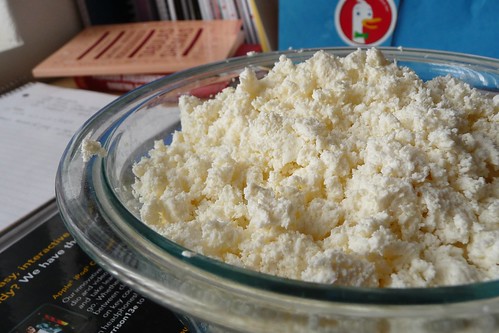Biezpiens, refined.

Yes, this is my messy desk, covered with notes and textbooks for my classes, books on Latvian language and my coupon organizer with its Duck Duck Go search engine sticker.
I've spoken in the past about Latvian biezpiens, roughly translated as "curdles." It's an essential part of making pankūkas, for one, and several desserts (like biezpiena maize).
It's also completely unavailable to me. You might find it in Brooklyn, maybe. And quark just doesn't cut it for me. It's just not the same. Since we can't easily go to Rimi and buy a pack or beg my mother-in-law's neighbor for some, we have to make it.
I've made biezpiens before, but every batch was different and I couldn't get it consistently working. It also relied too heavily on products that can be expensive or hard to obtain. Creamy kefir cheese, as much as I love it, isn't dry enough nor is it consistent in its texture, thanks to the lovely little live cultures driving my kefir production, for me to be able to consistently produce a nice biezpiens.
We've been experimenting with different methods of making it. And now, we've finally, finally found a way to make consistent, dry, crumbly biezpiens inexpensively, thanks to an accident while making ryazhenka.
Ideally, you need some form of press to press additional liquid out of the curdles when they're done being strained. If you don't have one, or can't rig one up, it's okay, but they won't be as dry.
Originally, I described my press here, but I've decided to break it out into its own post with pictures. Check it out here.
We tested two different methods: one with the oven and one with our rice cooker. The rice cooker is definitely our favorite - it's low, slow and unlikely to cause a mess. I believe that a slow cooker on its lowest setting would also work but please check it often. The oven method is faster but if you move wrong, you'll splash buttermilk all over and make a huge mess. Be warned.
We used one half-gallon plus a quart for the tests and wound up with about a pound of biezpiens, which packed our 1 quart bowl. Plenty, in short, for Jāņu siers and some pankūkas for dinner the next day.
Biezpiens, Refined [printable recipe]
Yield: About 3/4 pound per half-gallon of buttermilk Rice/Slow Cooker Method- 1/2 gallon buttermilk
- 1/2 gallon buttermilk